The Radio magazine has repeatedly raised the issue about the low sound quality of many of the acoustic system (as), manufactured by our industry. Over a long period, they remained the weakest link in the audio path. In recent years there have been AC pretty high class, such as 35 ° C-021 ("Estonia"), 35 ° C-012 (S-90). However, while they are available in insufficient quantities, roads and have considerable dimensions. Modern consumer when buying AC compelled also be guided not only by its parameters, but to consider the possibility of placing her in the living room. And from this point of view the greatest interest could provide an inexpensive small-sized AC average power in proper acoustic design. Here, by the way, I want to emphasize that exist among radio Amateurs of the opinion that the more power, the better the speaker, not quite true. A much more important parameter determining the quality of the system is its ability to reproduce without distortion dynamic range signal, which is determined by the sensitivity. The increase of 3 dB is equivalent to a higher power to AC twice.
Taking into account considerations was constructed of high-quality small speakers (see 3rd S. of the tab), the description of which is offered to the readers.
Main technical characteristics The rated (nameplate) power 15(35) W Nominal electrical resistance of 4 Ohms Nominal frequency range 40...20 000 Hz Frequency response in the frequency range 50...18 000 Hz, ±4 DB Characteristic sensitivity 86 dB/W/m Summary characteristic harmonic when electric power corresponding to the average sound pressure 94 dB in the frequency range, Hz; 1000...2000 to 1.5% 2000...6300 1% Dimensions mm HG Weight 14 kg
A schematic diagram of an enable dynamic heads and barrier filters AC shown in Fig.1.
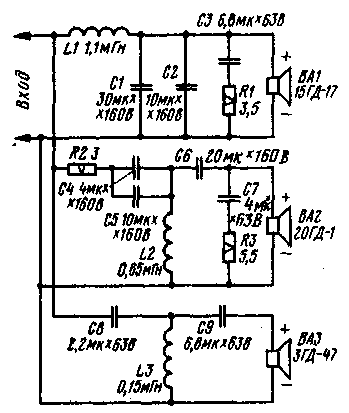
Fig.1
This three-way system, made in the form of a phase inverter based low-frequency (LF) GD-17, medium frequency (MF) GD-1 and high-frequency (HF) DDG-47 heads (their main specifications are given in the table).
Specifications
Head
GD-17
GD-1
DDG-47
6ГLW-4
Frequency range, Hz
63 5500...
630 10 000...
2 000 20 000...
3 25 000 150...
The main resonance frequency, Hz
35 391...)
480
1600
3000
Characteristic sensitivity (dB/W/m
87,5
87.5
91
93
Nominal electrical resistance, Ohm
4
8
8
8
The head resistance of the DC. OM2)
3,5
5,4
7,2
7,2
The inductance of the voice coil, mH
0,07 0,1...
0,135
-
-
Equivalent volume, dm3
24...30
-
-
-
Full figure of merit
0,36 0,25...
-
-
-
1) Variation for party of six heads.
2) taking into account the resistance of the wire that connects the head to the separation filter.
Volume bass reflex (l) selected based on technical characteristics of bass drivers GD-17 and is optimal from the point of view of obtaining a flat frequency response at high efficiency [1, 2]. The use dome head closed type GD-1, which does not require protective box, helped preserve the useful volume of the speaker without increasing its size, and to obtain a wider beamwidth than when using conventional cone midrange head, for example, GD-11.
In the described design has two symmetrically arranged bass reflex tunnel, which allowed while maintaining unchanged the area of their cross section and frequency settings. significantly reduce their length, which is important for small-sized AC. The crossover frequency filters (1000 and 6000 Hz) are chosen to ensure a minimum uneven frequency response. As a low-pass filter used second order slope frequency response at 12 dB / octave, and the mid-frequency and high-frequency - high-pass filter of the third order with slope frequency response of 18 dB per octave. The work dome midrange head GD-1 with a bandpass filter of the second order is not recommended because it leads to poor coordination of its radiation with the radiation tweeters.
The use of the described crossover required common-mode enable heads, providing a good phase and frequency response.
The case of the AU (Fig.2) is of a rigid design that made it possible to eliminate noise from the secondary radiation of the walls.

Fig.1. The front panel and the cutaway acoustic system:
1 back wall; 2 - the block separation filters; 3 - SG connector-3;
4 - the sound-absorbing material; 5 - upper wall; 6 - bass reflex tunnel;
7 - protective casing tweeters; 8 - HF head GD-47; 9 - trim
HF; 10 - protective mesh tweeters;11 - MF head GD-1;
12 is a decorative overlay CQ head; 13 - mounting plate CQ head;
14 is a strip of sponge rubber; 15 - bass head GD-17; 16 - protective mesh
Bass drivers; 17 - decorative moulding bass drivers; 18 - lateral wall; 19 - front panel.
Drawings of the front panel 19, the top and bottom 5, side 18 and rear walls 1 shown in Fig.3, 4
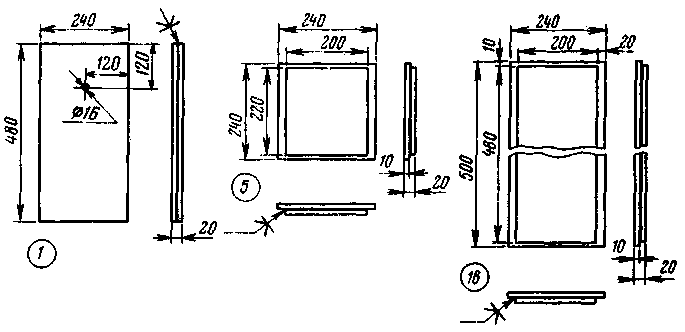
Fig.3. Drawings of the walls

Fig.4. A drawing of the front panel.
They are made of two glued (PVA) with each other sheets of plywood with a thickness of 10mm With the technology of manufacturing of casings can be found in [3]. The entire inner surface of the housing (excluding front panel) plastered with sound-absorbing material 4 (felt). Head 8, 11, 15 located on the front, along the axis of symmetry. They are all protected with decorative moldings 9, 12, 16 (Fig.5), and the woofers and tweeters and nets 10, 17.
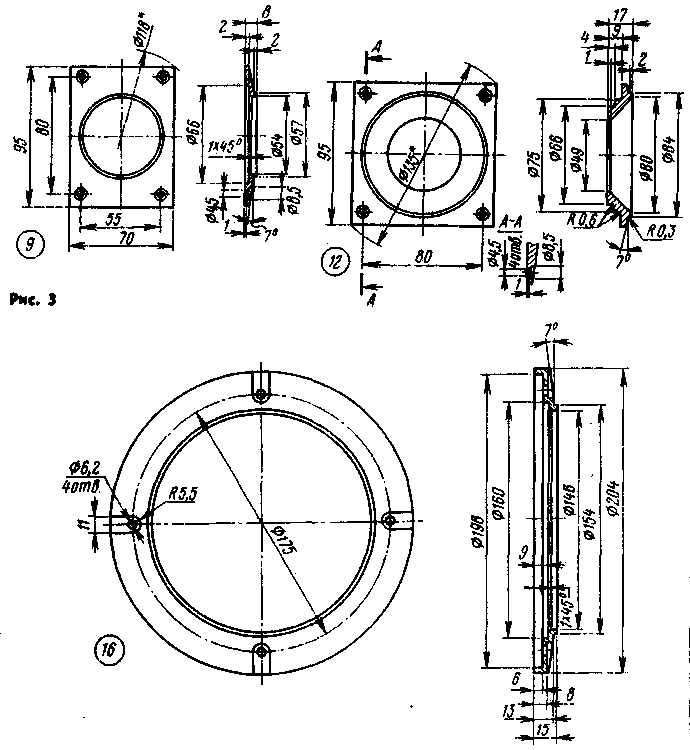
Fig.5
Bass head mounted on the front panel through a lining 14 of porous rubber. The same strip is put under its decorative overlay (Fig.2, it is not shown). CQ head is mounted on the panel through the foam pad, which is also not shown in Fig. 2. Sealing tweeters achieved by the use of the casing 7 is filled with sound absorbing material (cotton). The bass reflex tunnel 6 is made of ebonite, but you can use cardboard or soft grade plastic. On the back wall of the connector 3 to connect the speakers to the amplifier CC and fixed fee with 2-separation filters (see Fig.6).

Fig.6. Charge separation filters.
Coil filters wound on a frame of insulating material with a diameter of 50 (L1) and 24 mm (L2, L3), the winding ordinary, its length respectively 25 and 12 mm, diameter 80 cheeks and 54 mm Coil L1 contains 132, L2 - 146, and L3 - 68 turns of wire sew-2 diameter of 1.84, and 0.83 and 1.2 mm, respectively.
In the filters used capacitors KG-1 (C1, C2, C3) and MBGO (C4, C5), resistors sew (you can PAVR and C5-16).
Subjective evaluation by means of the "pairwise comparison" of the sound of this speaker and industrial designs 15 ° C-208, 15 ° C-109, 25 ° C-109, 25 ° C-027 showed some of the benefits of a homemade system parameters such as naturalness, purity and transparency. AFC AC. as well as the dependence of the modulus of the electrical impedance of the loudspeaker ¦Z ¦frequency (red curve) shown in Fig.7.

Fig.7. The frequency response of the AU and its dependence of the scalar impedance of Z with frequency.
It should be noted that the design box speaker, you can instead tweeters GD-47 to install him as the head 6ГLW-4 (old name GD-13), does not require protective casing and having a wider dynamic range, lower harmonic distortion and greater efficiency. Variant of its fastening on the front panel of the speaker shown in Fig.8, and the frequency and the dependence of absolute impedance ¦Z ¦of the frequency (dashed line) in Fig.9.
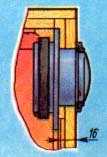
Fig.8. Optional mounting tweeters 6ГLW-4.
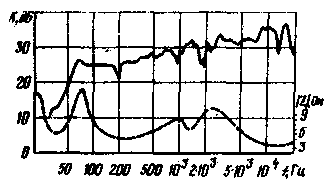
Fig.9
The design of the AC has been tested in the Moscow electrotechnical Institute of communications. The authors Express deep appreciation for this work to the staff of the Department of radio and electro-acoustic.
Literature
Authors: V. Demidov, E. Zemskov, Moscow; Publication: N. Bolshakov, rf.atnn.ru






